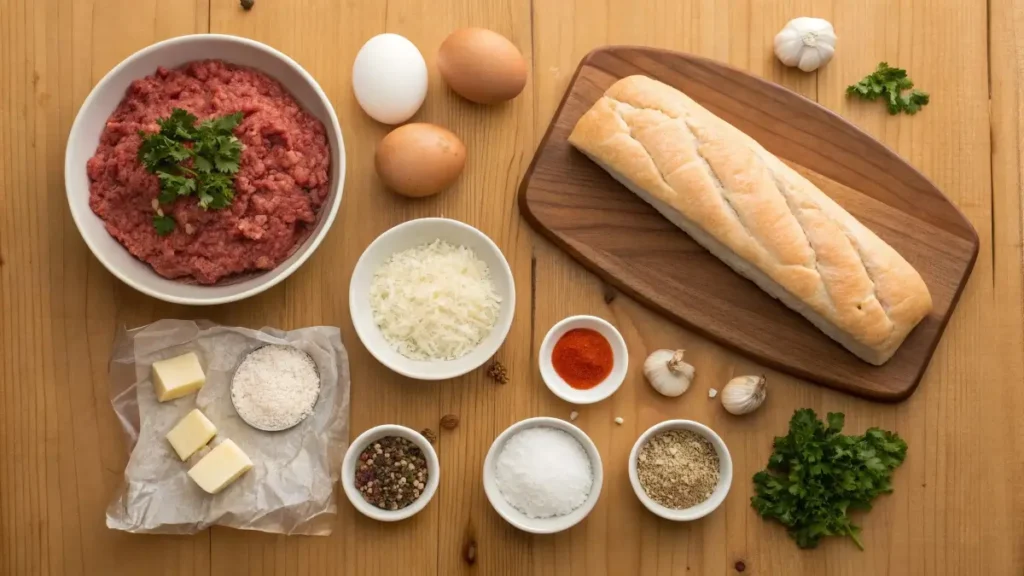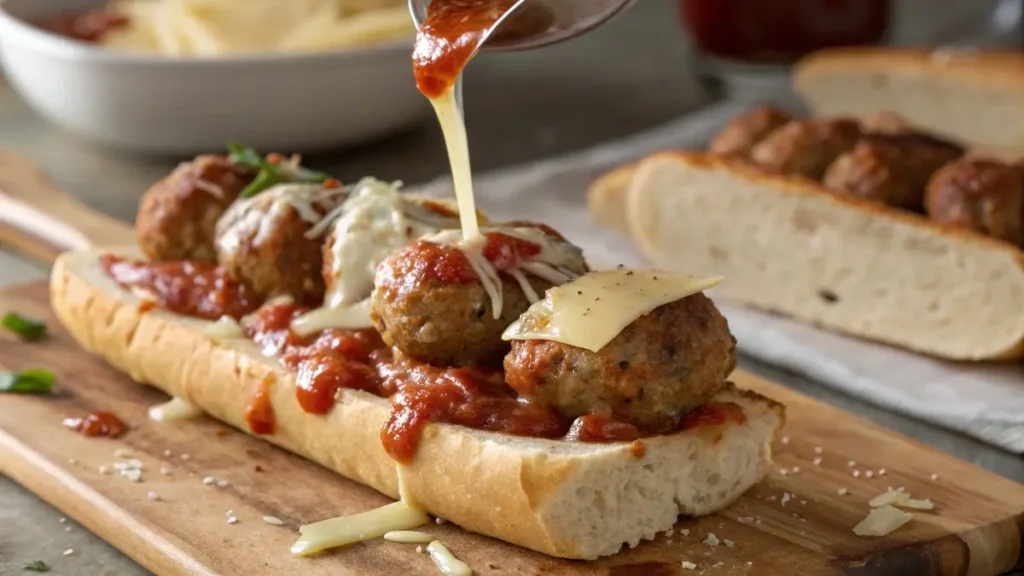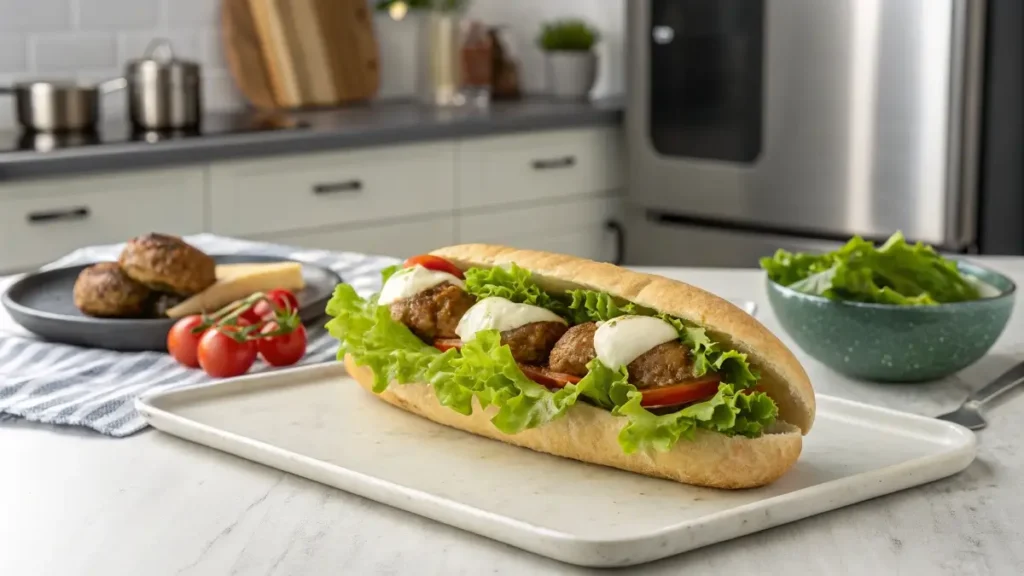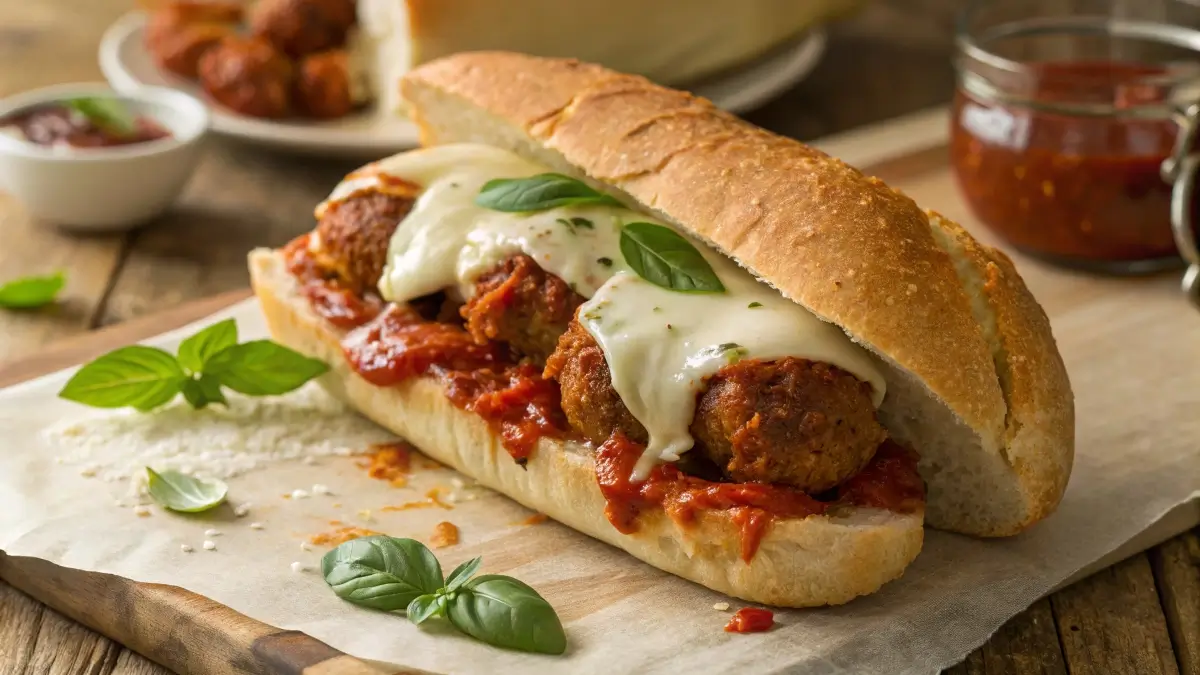Ultimate Turkey Meatball Sub Recipe Guide (Juicy, Saucy & Irresistible)
If you’ve ever bitten into a messy, saucy meatball sub and wished it was just a little lighter, you’re in for a treat. This turkey meatball sub recipe delivers all the bold flavors of a classic Italian-style sandwich, without the grease overload. Imagine tender turkey meatballs smothered in zesty marinara, topped with melty cheese, and tucked into golden, toasted hoagie rolls. Whether you’re meal-prepping for the week, hosting a casual game-day lunch, or just need a weeknight comfort fix, this guide has you covered.
From choosing the right meat blend to crafting the perfect sauce and avoiding soggy bread disasters, we’ll walk you through every single detail. Plus, we’ll include some clever twists—like gluten-free options and kid-approved swaps. Ready to build your next signature sandwich? Let’s dive in.
Looking for inspiration? Try our delicious spiced Cajun turkey recipe for flavor-packed ideas to level up your turkey game.
Table of Contents
Why the Turkey Meatball Sub Recipe is the Sandwich You’re Missing
The Rise of Turkey in Modern Comfort Food
For decades, beef ruled the sub sandwich world. But as more people aim to eat lighter without sacrificing satisfaction, ground turkey has stepped up. It’s leaner than beef, but when seasoned and cooked right, turkey brings out savory, juicy, and slightly sweet notes that pair beautifully with classic Italian flavors.
Turkey’s versatility makes it a perfect base for meatballs—it soaks up spices like garlic, onion, parsley, and red pepper without becoming greasy. It’s also an excellent choice for those watching their saturated fat intake or avoiding red meat.
What Makes Turkey Meatballs Healthier Yet Tasty?
There’s a fine balance between healthy and flavorless, but turkey meatballs nail it when done right. By using 93% lean ground turkey, you get enough fat to keep things juicy, yet cut down on the calorie load. Adding ingredients like grated parmesan, minced onion, and soaked breadcrumbs helps bind the meatballs and enhances texture without drying them out.
You also have the freedom to choose clean, whole ingredients—no fillers, no preservatives—making this turkey meatball sub recipe as wholesome as it is hearty.
And guess what? These turkey meatballs don’t skimp on flavor. When paired with a zesty marinara and blanketed in melted cheese, they offer that nostalgic meatball sub feel—but with a better-for-you twist.
Core Ingredients for the Perfect Turkey Meatball Sub Recipe
Best Ground Turkey for Meatballs: Lean or Fatty?
When it comes to ground turkey, not all blends are created equal. For a tender, flavorful turkey meatball sub recipe, you’ll want a mix that’s around 93% lean and 7% fat. This ratio gives your meatballs enough fat to stay moist during baking or frying, but not so much that they become greasy or heavy.
Going ultra-lean (like 99%) might sound like a smart move, but it can result in dry, crumbly meatballs unless you’re compensating with rich ingredients like ricotta or oil. And if you’re wondering—yes, dark turkey meat can add depth, but it’s often harder to find pre-ground in stores.
Try asking your butcher for custom blends if you want to control the fat content. But for most people, 93/7 pre-packaged ground turkey strikes the perfect balance between health and flavor.
Binding and Flavor: Parmesan, Garlic, Herbs & More
A meatball is only as good as what goes into it. To elevate your turkey meatballs beyond bland, start with these key ingredients:

| Ingredient | Purpose |
|---|---|
| Breadcrumbs (plain or panko) | Helps bind and retain moisture |
| Egg | Essential for structure and cohesion |
| Grated Parmesan | Adds umami, saltiness, and richness |
| Garlic (minced) | Infuses classic Italian flavor |
| Onion (grated or finely diced) | Adds moisture and a subtle sweetness |
| Fresh Parsley or Basil | Brings freshness and color |
| Red Pepper Flakes | Optional heat kick |
| Salt & Pepper | Foundational seasoning |
Here’s a quick flavor tip: soak your breadcrumbs in milk or broth for a few minutes before mixing. This trick makes the meatballs soft and tender inside.
And don’t skip the parmesan. That salty, nutty flavor acts like a turbocharger for the otherwise mild turkey. The herbs? Go fresh if possible—they make a massive difference in aroma and taste.
Discover great ideas like these in our Tuscan chicken meatballs with gnocchi recipe where herbs and cheese play a leading role in the flavor game.
Once you’ve nailed the foundation, you’re set up for success in the next steps—cooking and saucing these beauties to perfection.
How to Make Juicy Turkey Meatballs That Don’t Dry Out
Techniques for Moisture-Rich Meatballs
Let’s face it—turkey can dry out fast if you don’t treat it right. But with a few chef-approved techniques, you’ll get juicy meatballs that hold together, stay tender, and burst with flavor in every bite of your turkey meatball sub.
Here’s what works:
- Avoid overmixing — combine the ingredients just until incorporated to keep the meatballs tender. Over-mixing toughens the texture.
- Use soaked breadcrumbs – Known as a panade, this combo of breadcrumbs and milk (or broth) locks in moisture.
- Grate instead of chop – Grated onions and garlic integrate better and release more flavor and liquid.
- Chill before cooking – Let the meatballs rest in the fridge for 15–30 minutes so they firm up before hitting the pan or oven.
- Bake or air fry – These methods help cook evenly without drying out the surface. If pan-frying, go low and slow.
Bonus tip? Drizzle a little olive oil or melted butter over the meatballs before baking. This method forms a golden crust on the outside while locking in juicy moisture inside.
Pan-Frying vs. Baking vs. Air Fryer: Which Is Best?
Choosing your cooking method depends on what you value most: flavor, convenience, or health. Here’s a quick comparison:
| Method | Pros | Cons |
|---|---|---|
| Pan-Frying | Deep browning, rich flavor | Can dry out meatballs if overcooked |
| Baking | Easy to do in batches, hands-free | Less browning unless you broil at the end |
| Air Fryer | Crispy exterior, fast cooking, lower fat content | May dry edges if overcrowded or overcooked |
For this turkey meatball sub recipe, baking is the sweet spot—especially if you finish under the broiler for that crispy, golden top. It’s a quick, healthier alternative to frying that also maintains the meat’s natural tenderness.althier than frying, and helps preserve tenderness.
Don’t miss our smothered chicken recipe for more ideas on locking in moisture and flavor without extra fat.
Whichever method you choose, always check for doneness with a meat thermometer. Turkey meatballs should hit an internal temp of 165°F to be safe and delicious.
Crafting the Ultimate Sauce for Your Turkey Meatball Sub
What Sauce Works Best with Turkey Meatballs?
Let’s not sugarcoat it—the sauce can make or break your meatball sub. For turkey meatballs in particular, your sauce needs to complement the lightness of the meat without overpowering it.
The classic marinara sauce is the gold standard. Its rich tomato base, accented with garlic, basil, and oregano, adds brightness that lifts the flavor of turkey meatballs. But you can absolutely experiment.
Here are a few sauce styles that pair beautifully with a turkey meatball sub recipe:
| Sauce | Flavor Profile |
|---|---|
| Marinara | Classic, balanced, slightly sweet |
| Arrabbiata | Spicy and bold |
| Tomato Basil Cream | Smooth, mild, with a creamy richness |
| Pesto (light coating) | Herbal and nutty, for a Mediterranean twist |
| BBQ-Tomato Blend | Sweet, smoky, and tangy—a Southern remix |
Avoid overly sugary or thick sauces—they’ll drown the sandwich and fight the subtle flavor of turkey. And keep it simple. A sauce with too many ingredients can clash with the texture of the meatballs and the bread.
Homemade Marinara vs. Store-Bought Options
Here’s the real talk: while store-bought sauces can save time, they’re often loaded with added sugars, preservatives, and unnecessary oils. Making a quick homemade marinara takes just 20 minutes, and the flavor payoff is totally worth it.
Quick Homemade Marinara Sauce (Serves 4):
- 2 tbsp olive oil
- 4 garlic cloves, minced
- 1 can (28 oz) crushed tomatoes
- 1 tsp dried oregano
- ½ tsp red pepper flakes
- Salt & pepper to taste
- Handful of fresh basil, chopped (optional)
Instructions:
Heat the olive oil in a saucepan over medium heat. Add garlic and sauté for 1 minute. Pour in the crushed tomatoes and seasonings. Simmer uncovered for 15–20 minutes, stirring occasionally. Toss in basil before serving.
If you’re short on time, go with a clean-label marinara like Rao’s or a Whole Foods 365 version. Just scan the ingredients—look for simple items like tomatoes, olive oil, onions, and spices.
Check out this garlic parmesan chicken pasta for another flavor-forward sauce that would work well on your sub in a pinch.
When done right, your sauce won’t just sit on the sandwich—it’ll mingle with the cheese, soak slightly into the bread, and tie the whole sub together with that perfect, saucy bite.
Building the Sub: Bread Choices and Smart Layering
Best Bread for Meatball Subs: Toasted Hoagies & Rolls
Let’s be honest—bad bread can ruin a meatball sub, no matter how perfect the meatballs or sauce are. For a solid turkey meatball sub recipe, your bread needs to be soft inside yet sturdy enough to hold up to the sauce.

Here are your best bread options:
| Bread Type | Why It Works |
|---|---|
| Italian Hoagie Roll | Classic choice, slightly crusty, pillowy interior |
| Ciabatta Roll | Crunchy, rustic, great for extra sauce |
| Sub Roll (hero/torpedo) | Balanced softness and structure |
| Baguette (short cut) | Super crispy crust, fancy presentation |
| Gluten-Free Rolls | Great for dietary needs, toast before using |
Whatever bread you choose, toasting is non-negotiable. A lightly toasted roll prevents sogginess and gives the sandwich a satisfying crunch. Simply split the roll, brush the insides with olive oil or garlic butter, and toast in a 375°F oven for 5 minutes until golden.
You can also add a sprinkle of shredded mozzarella or provolone before toasting—let it melt into the roll and form a base layer that keeps the bread dry and cheesy.
Smart Layering Techniques to Prevent Sogginess
Nobody likes a soggy sandwich, especially not one dripping with marinara. So here’s how to layer like a pro:
- Base Layer of Cheese – Lay provolone or mozzarella directly on the toasted roll. This creates a barrier that shields the bread from absorbing too much sauce.
- Add the Meatballs – Place 3 to 4 meatballs in a line, gently pressing them down so they stay put.
- Spoon the Sauce – Add sauce sparingly—you want enough for flavor, not a flood.
- Top with More Cheese – This will melt over the meatballs when baked and glue everything together.
- Optional Toppings – Fresh basil, red onion slivers, pickled banana peppers, or a drizzle of garlic aioli.
Once assembled, place the entire sub back in the oven for 3–5 minutes under the broiler. This final bake melts the cheese and crisps the top edges of the bread, locking in all those savory layers.
Discover great ideas like the layered textures in this chicken ricotta meatballs with spinach alfredo sauce recipe—proof that great layering isn’t just for sandwiches.
With the bread perfectly toasted and the layers balanced just right, you’re well on your way to mastering this meatball masterpiece.
Cheese, Toppings & Garnish Ideas to Elevate Your Sub
What Cheese Melts Best? Provolone, Mozzarella & More
Let’s talk cheese—the heart and soul of any meatball sub. When melted just right, it wraps the turkey meatballs in gooey goodness and locks in moisture. The goal is that stretchy, golden top layer that clings to the meatballs and bread in each bite.
Here are your best options for cheese in a turkey meatball sub recipe:
| Cheese | Why It Works |
|---|---|
| Provolone | Mild, buttery, melts beautifully |
| Mozzarella | Classic, creamy, perfect stretch factor |
| Parmesan | Salty punch when sprinkled on top |
| Fontina | Smooth and rich with a nutty edge |
| Italian Blend | Combines mozzarella, provolone, and romano |
Best practice? Use a combo: mozzarella for meltiness, provolone for sharpness, and a final dusting of parmesan after baking for that pizzeria-style finish.
Want to get gourmet? Add a touch of ricotta cheese to the inside of the bun for a creamy surprise bite.
Fresh Basil, Pickled Peppers & Creative Add-ons
Your sandwich doesn’t stop at meatballs and cheese. Toppings can transform a simple sub into something unforgettable. Whether you love crunch, heat, or herbaceous flavor, there’s a topping that belongs in your next build.
Try these crave-worthy additions:
| Topping | Flavor Boost |
|---|---|
| Fresh Basil or Oregano | Adds freshness and bright contrast |
| Red Onion Slivers | Crunchy and slightly sweet |
| Pickled Banana Peppers | Tangy with a bit of kick |
| Roasted Red Peppers | Smoky, sweet, and tender |
| Garlic Aioli or Mayo | Creamy richness that elevates every bite |
| Crushed Red Pepper Flakes | A hit of heat for spice lovers |
Looking to really take it over the top? Add a crispy element like toasted breadcrumbs or fried shallots before serving. They add irresistible crunch and soak up extra sauce like magic.
Check out this delicious dill pickle sandwich for bold, briny topping inspiration that can work beautifully in meatball subs too.
Remember, the toppings aren’t just extras—they’re texture, flavor, and personality. Get creative, keep it balanced, and always toast your sub after assembling to let those cheeses melt and the garnishes settle in.
How to Bake, Wrap, and Serve Like a Pro
Oven-Finishing Tips for Melty, Crispy Subs
Once your sub is assembled with perfectly cooked turkey meatballs, a generous spoonful of marinara, and layers of gooey cheese, you’re not done—finishing in the oven is key to elevating your sandwich from good to unforgettable.
Here’s how to nail it:
- Preheat your oven to 425°F – You want it hot enough to melt cheese fast without drying out the bread.
- Use parchment paper or foil on your baking tray to make cleanup a breeze.
- Place subs open-faced – This allows even melting and better heat distribution.
- Bake for 5–7 minutes, or until the cheese is melted and bubbling.
- Optional: Broil for 1–2 minutes at the end for a golden brown finish. Watch carefully—things move fast under the broiler.
Not only does this step bind the sandwich together, but it also crisps up the edges of the bread for that irresistible crunch when you bite in.
You can even sprinkle extra parmesan or fresh herbs right after baking for a final touch of flavor and flair.
Meal Prep and Wrapping Without Getting Soggy
Want to make your turkey meatball sub recipe ahead of time? Smart thinking—these sandwiches are perfect for meal prep or packing for lunch. But the trick is preventing them from turning into a soggy mess.
Here’s how to do it right:
- Store components separately – Keep the meatballs, sauce, and bread in different containers until you’re ready to eat.
- Toast the bread in advance – It creates a natural moisture barrier and holds up better when reheated.
- Wrap with parchment first, then foil – This double-wrap method insulates while letting some steam escape.
- Reheat wrapped in foil at 350°F for 10–12 minutes – No microwave mush, just warm, melty goodness.
If you’re taking your sub on the go, place a piece of lettuce or a slice of cheese directly against the bread before layering in sauce or meatballs. It helps buffer moisture during transit.
Don’t miss our easy edamame rice recipe for a smart and simple side dish to serve alongside a hearty sub, especially if you’re packing lunchboxes or prepping for multiple meals.
Whether you’re serving fresh from the oven or reheating for a next-day lunch, following these techniques ensures your sub stays crispy, cheesy, and totally satisfying.
Healthier Variations of the Turkey Meatball Sub Recipe
Low-Carb, Gluten-Free, and Dairy-Free Alternatives
If you love the comfort of a meatball sub but have specific dietary needs, you’re in luck. The beauty of this turkey meatball sub recipe lies in its versatility. With just a few tweaks, you can make it gluten-free, dairy-free, low-carb—or all three.
Let’s break it down by need:
For a Gluten-Free Sub:
- Use gluten-free hoagie rolls made from rice or oat flour.
- Substitute regular breadcrumbs with gluten-free panko, almond flour, or crushed rice crackers in the meatballs.
- Double-check your marinara for hidden gluten—some brands use flour as a thickener.
For a Low-Carb or Keto Version:
- Swap the bread for a low-carb wrap, large lettuce leaf, or serve your meatballs “naked” in a bowl with marinara and cheese.
- Top with high-fat cheeses like cheddar or mozzarella for satisfying richness.
For Dairy-Free Needs:
- Opt for nutritional yeast or plant-based parmesan to keep the recipe dairy-free without sacrificing flavor.
- Choose vegan mozzarella shreds or cashew cheese.
- Skip cheese altogether and add extra herbs or roasted veggies for flavor depth.
By mixing and matching the ingredients above, you can craft a custom sub that meets your health goals and satisfies your sandwich cravings.
Don’t miss our vegan breakfast burrito recipe for more plant-based ideas that work just as well for savory subs and wraps.

Kid-Friendly & Meal Prep Ideas
Turkey meatball subs are a huge hit with kids—but size and simplicity matter. Mini versions are easier to handle and just as fun to eat.
Here’s how to make them school-lunch or snack-approved:
- Use slider buns or split Hawaiian rolls for mini meatball sandwiches.
- Form small meatballs (1-inch) for faster cooking and easier bites.
- Let kids customize with toppings like shredded mozzarella, pickles, or even mild ranch drizzle.
For freezer meal prep, shape and bake a large batch of turkey meatballs, then freeze in sauce in individual containers. Pair with buns or wraps when you’re ready to build a quick, satisfying meal.
This approach not only saves time—it ensures a hot, hearty meal is never more than a few steps away.
Pairing Your Sub – Sides and Drinks That Make It a Meal
Classic Pairings: Chips, Coleslaw, and Pickles
A turkey meatball sub recipe on its own is satisfying—but pairing it with the right sides transforms it into a full-on, memorable meal. Whether you’re serving guests or prepping a hearty lunch, these side options hit the spot.
Here are some classic sides to consider:
| Side Dish | Why It Works |
|---|---|
| Kettle-cooked Chips | Crunchy contrast to soft meatballs and sauce |
| Homemade Coleslaw | Creamy, tangy, and freshens the palate |
| Garlic Roasted Broccoli | Adds nutrients and crunch without heaviness |
| Pickle Spears | Salty-sour element cuts through the richness |
| Caprese Salad | Light, fresh, and echoing the Italian flavor profile |
Looking for low-carb pairings? Serve your sub with a side salad of arugula, cherry tomatoes, and balsamic vinaigrette or roasted cauliflower tossed in garlic and herbs.
Refreshing Beverages to Serve With It
Great food deserves a great drink. Whether you want something bold, bubbly, or refreshing, there’s a beverage to balance the richness of a meatball sub.
Try these crowd-pleasing options:
- Sparkling water with lemon or lime – simple and refreshing
- Iced herbal tea – mint, hibiscus, or green tea cool the palate
- Root beer or craft soda – perfect for a casual, nostalgic meal
- Red wine – a Chianti or Zinfandel pairs beautifully with marinara
- Lager or light ale – ideal for game-day vibes
If you’re planning a themed gathering or game night, create a mini bar with a few drink options and let guests choose their pairing.
Learn more about side options for a balanced plate in our gluten-free summer salads roundup—many of them pair perfectly with hot sandwiches like this.
Conclusion
Making the perfect turkey meatball sub recipe at home is easier than you think—and the rewards are delicious. Whether you stick with the Italian classic or explore gluten-free, low-carb, or dairy-free versions, the possibilities are endless.
From juicy, herb-infused meatballs to melty cheese and toasted bread that resists sogginess, this guide gives you everything you need to master the art of the turkey meatball sub. Pair it with crisp chips, a light salad, and a refreshing drink—and you’ve got a sandwich meal worth sharing.
Check out this satisfying bibibop chicken marinade recipe if you’re looking for another bold, protein-packed favorite next!
FAQs
What is the best sauce to put on a meatball sub?
The best sauce is a classic marinara, known for its tangy and savory flavor that complements turkey meatballs. For variety, try spicy arrabbiata, creamy tomato basil, or even a smoky BBQ-marinara blend.
What to put in turkey meatballs?
Essential ingredients include ground turkey (93% lean), breadcrumbs, egg, grated parmesan, garlic, onion, parsley, salt, and pepper. Optional red pepper flakes or Italian seasoning can enhance the flavor.
What sauce can you use with turkey meatballs?
Besides marinara, turkey meatballs pair well with creamy mushroom sauce, pesto, buffalo sauce, or tzatziki for a Mediterranean twist.
What is the best thing to put on a meatball sub?
Melty cheeses like mozzarella or provolone, fresh basil, garlic aioli, and pickled peppers. Toasted bread and a light sauce layer complete the perfect sub.
How to elevate a meatball sub?
Use artisan bread, homemade sauce, toasted cheese topping, fresh herbs, and texture-boosting extras like crispy onions or arugula.
How to prevent meatball subs from getting soggy?
Toast the bread, layer cheese beneath the meatballs, use thick sauce sparingly, and serve immediately after assembly or reheating.

